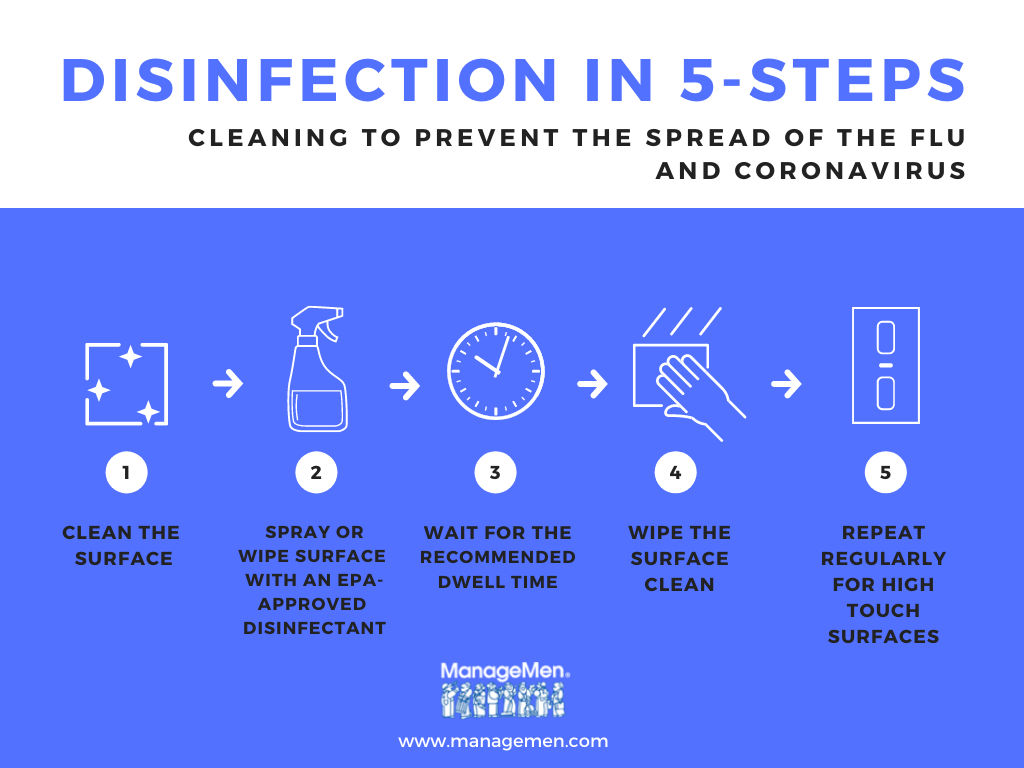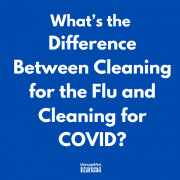What’s the Difference Between Cleaning for the Flu and Cleaning for COVID?
With warnings of a “twin-demic,” and “mingling” of COVID with the flu during the upcoming winter, health experts are urging everyone to prepare for a tough season. While these respiratory illnesses are caused by different viruses, it can be difficult to distinguish between the two. To further complicate matters, the Centers for Disease Control and Prevention (CDC) says that it’s also possible to have the flu and COVID-19 at the same time.
One thing we know is that both viruses can spread through contaminated surfaces. That’s why it’s critical that we pay extra attention to our cleaning and disinfection programs this winter.
| What We Know: The Flu According to the CDC: | What We Know: COVID-19 According to the CDC: |
| — The U.S. experienced 24,000-62,000 flu-related deaths during the 2019-20 flu season. | — There have been approximately 180,000 deaths in the U.S. involving COVID-19. |
| — The flu virus can live and potentially infect a person for up to 48 hours after being deposited on a surface. | — Coronaviruses on surfaces and objects naturally die within hours to days. |
| — Flu viruses are relatively fragile, so standard cleaning and disinfecting practices are sufficient to remove or kill them. | — Normal routine cleaning with soap and water removes germs and dirt from surfaces. It lowers the risk of spreading COVID-19 infection. |
| — Special cleaning and disinfecting processes, including wiping down walls and ceilings, frequently using room air deodorizers, and fumigating, are not necessary or recommended. | — EPA-approved disinfectants are an important part of reducing the risk of exposure to COVID-19. |
| — If disinfectants on this list are in short supply, alternative disinfectants can be used (for example, 1/3 cup of bleach added to 1 gallon of water, or 70% alcohol solutions). |
So, what does the confluence of these two viruses mean for you? Well, as you prepare for the upcoming winter, you should get a flu shot—and you should take a good look at how your home or workplace is cleaned.
Where we’ve seen a lot of organizations err throughout the start of the pandemic is in their exclusive focus on disinfection. And it’s understandable. With all the images of heavily suited workers creating the perception that fogging and spraying disinfectant everywhere is how to best prevent the spread of COVID-19, a lot of people forget about the fact that cleaning and disinfection always go hand in hand.

But even before that, we should first make sure everyone has the proper training and personal protective equipment (PPE).
So how does cleaning for the flu differ from how we clean for coronavirus and COVID-19? It doesn’t.
Understanding the Terms
As we think about keeping surfaces free from viruses, another frequent area of confusion is distinguishing between cleaning, sanitizing and disinfecting.
Again, the CDC defines these terms as follows:
Cleaning: Removes germs, dirt, and impurities from surfaces or objects. Cleaning works by using soap (or detergent) and water to physically remove germs from surfaces. This process does not necessarily kill germs, but by removing them, it lowers their numbers and the risk of spreading infection.
Sanitizing: Lowers the number of germs on surfaces or objects to a safe level, as judged by public health standards or requirements. This process works by either cleaning or disinfecting surfaces or objects to lower the risk of spreading infection.
Disinfecting: Kills germs on surfaces or objects. Disinfecting works by using chemicals to kill germs on surfaces or objects. This process does not necessarily clean dirty surfaces or remove germs, but by killing germs on a surface after cleaning, it can further lower the risk of spreading infection.
It should be noted that if you are using a sanitizer to clean for COVID, there’s a chance it does not specifically eliminate coronavirus from the surface. Only EPA-registered disinfectants and germicides should be used.
Spread Knowledge, Not Viruses
There’s a lot of misunderstanding around how to properly clean and disinfect for both the flu and COVID. Whether you’re in charge of a commercial cleaning operation or a teacher in a school, we’d encourage you to share this knowledge with others.
While it’s likely custodial teams will be increasing cleaning frequencies in your facility, we all can play a role in keeping surfaces virus-free and preventing the spread of illneses.


